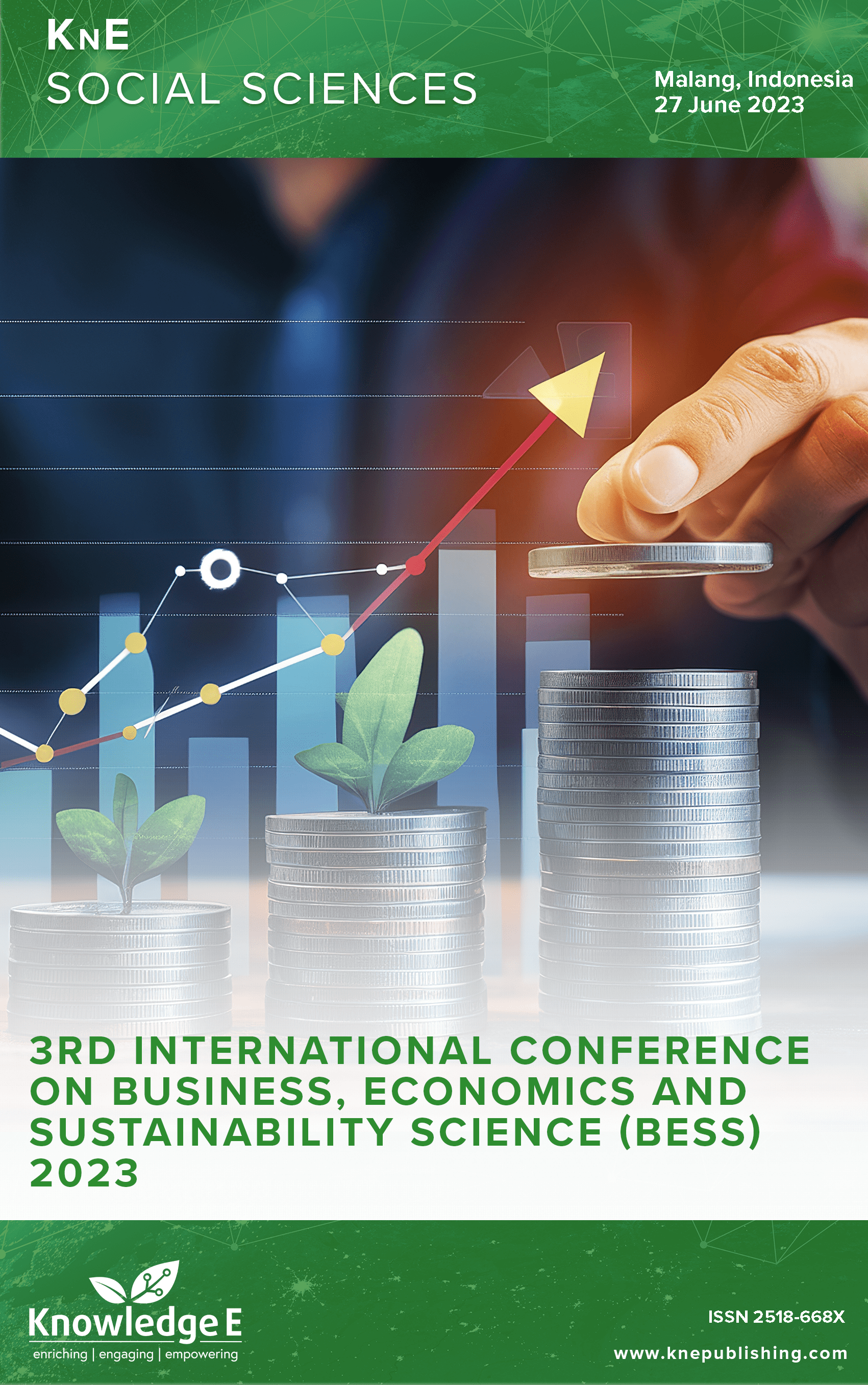Financial Revolution through Agent-based Artificial Simulation Computational Models for Predicting Market Behavior
DOI:
https://doi.org/10.18502/kss.v9i21.16771Abstract
The fundamental theory of the Efficient market hypothesis (EMH), which states that market participants are rational, has received a lot of criticism. The complexity of behavior in the capital market is still a black box, especially when psychological biases influence aggressively on decision-making amid uncertainty. Experimental research on finance and capital markets in the form of AI using machine learning seeks to predict the results of more complex interactions. This multidisciplinary approach offers efforts to explain social phenomena from the micro level to macro descriptions which are built artificially through the computational world. The processing modeling approach is preferred because it includes the complexes that emerge from the behavior and interactions of individuals in the real world. Agent Based Model (ABM) is an AI approach in the form of computational simulation that performs a bottom-up approach by combining irrational–rational agent interactions through networks in microenvironments. Using the ABM approach through Netlogo computing, this study proves that AI can be used to analyze investor behavior in the capital market.
Keywords: Agent Based Model, artificial intelligence, investor behavior
References
Delcey T. Samuelson vs fama on the efficient market hypothesis: the point of view of expertise. OEconomia. 2019;9(1):37–58. DOI: https://doi.org/10.4000/oeconomia.5300
Shiller RJ. From efficient markets theory to behavioral finance. J Econ Perspect. 2003;17(1):83–104. DOI: https://doi.org/10.1257/089533003321164967
López-Cabarcos MÁ, Pérez-Pico AM, Vázquez-Rodríguez P, López-Pérez ML. Investor sentiment in the theoretical field of behavioural finance. Ekon Istraz. 2020;33(1):2101– 19. DOI: https://doi.org/10.1080/1331677X.2018.1559748
Paule-Vianez J, Gómez-Martínez R, Prado-Román C. A bibliometric analysis of behavioural finance with mapping analysis tools. Eur Res Manag Bus Econ. 2020;26(2):71–7. DOI: https://doi.org/10.1016/j.iedeen.2020.01.001
OECD. (2021). Artificial Intelligence, Machine Learning and Big Data in Finance: Opportunities, Challenges, and Implications for Policy Makers. In OECD business and finance outlook 2020 : sustainable and resilient finance.
Berdiyeva O, Islam MU, Saeedi M. Artificial Intelligence in Accounting and Finance: Meta-Analysis. NUST Business Review. 2021;3(1): https://doi.org/10.37435/nbr.v3i1.29. DOI: https://doi.org/10.37435/nbr.v3i1.29
Situngkir H, Surya Y. Agent-based Model Construction in Financial Economic System. Arxiv Preprint Nli. 2004;(0403041):1.
Macal CM, North MJ. (2008). Agent-based modeling and simulation: ABMS examples. Proceedings - Winter Simulation Conference. https://doi.org/10.1109/WSC.2008.4736060. DOI: https://doi.org/10.1109/WSC.2008.4736060
Richiardi MG. The future of agent-based modeling. East Econ J. 2017;43(2):271–87. DOI: https://doi.org/10.1057/s41302-016-0075-9
Jackson JC, Rand D, Lewis K, Norton MI, Gray K. Agent-Based Modeling: A Guide for Social Psychologists. Soc Psychol Personal Sci. 2017;8(4):387–95. DOI: https://doi.org/10.1177/1948550617691100
Paulin J, Calinescu A, Wooldridge M. Understanding flash crash contagion and systemic risk: A micro–macro agent-based approach. J Econ Dyn Control. 2019;100:200–29. DOI: https://doi.org/10.1016/j.jedc.2018.12.008
Kukacka J, Kristoufek L. Do ‘complex’ financial models really lead to complex dynamics? Agent-based models and multifractality. J Econ Dyn Control. 2020;113:103855. DOI: https://doi.org/10.1016/j.jedc.2020.103855
Lee S, Lee K. 3% rules the market: herding behavior of a group of investors, asset market volatility, and return to the group in an agent-based model. J Econ Interact Coord. 2021;16(2):359–80. DOI: https://doi.org/10.1007/s11403-020-00299-x
Heppenstall A, Malleson N, Crooks A. “Space, the Final Frontier”: How Good are Agent-Based Models at Simulating Individuals and Space in Cities? Systems (Basel). 2016;4(1):9. DOI: https://doi.org/10.3390/systems4010009
Qin Y, Freebairn L, Atkinson JA, Qian W, Safarishahrbijari A, Osgood ND. (2019). Multiscale simulation modeling for prevention and public health management of diabetes in pregnancy and sequelae. Lecture Notes in Computer Science (Including Subseries Lecture Notes in Artificial Intelligence and Lecture Notes in Bioinformatics), 11549 LNCS. https://doi.org/10.1007/978-3-030-21741-9_26. DOI: https://doi.org/10.1007/978-3-030-21741-9_26
Siagian TH, Prasojo AP. Agent-Based Modelling Pada Studi Kependudukan: Potensi dan Tantangan. Seminar Nasional Official Statistics. 2021;2020(1):1032–40. DOI: https://doi.org/10.34123/semnasoffstat.v2020i1.591
Prasetyo Y. COMPUTATIONAL SOCIOLOGY: APPLICATION AND DEVELOPMENT. Jurnal Partisipatoris. 2019;1(1): https://doi.org/10.22219/jp.v1i1.7830. DOI: https://doi.org/10.22219/jp.v1i1.7830
Krugman P. (2009). How did economists get it so wrong? New York Times.
Fama EF. Efficient Capital Markets: A Review of Theory and Empirical Work. J Finance. 1970;25(2):383. DOI: https://doi.org/10.2307/2325486
Subramanian K. Efficient market hypothesis: the model that failed. Econ Polit Wkly. 2010;45(31).
Gippel JK. A revolution in finance? Aust J Manag. 2013;38(1):125–46. DOI: https://doi.org/10.1177/0312896212461034
Tadapaneni NR. Artificial Intelligence in Finance and Investment. Int J Innov Res Sci Eng Technol. 2020;9(5).
Kumari B, Kaur J, Swami S. System Dynamics Approach for Adoption of Artificial Intelligence in Finance. Lecture Notes in Mechanical Engineering; 2021. https://doi.org/10.1007/978-981-15-8025-3_54. DOI: https://doi.org/10.1007/978-981-15-8025-3_54
Brandon N, Dionisio KL, Isaacs K, Tornero-Velez R, Kapraun D, Setzer RW, et al. Simulating exposure-related behaviors using agent-based models embedded with needs-based artificial intelligence. J Expo Sci Environ Epidemiol. 2020 Jan;30(1):184– 93. DOI: https://doi.org/10.1038/s41370-018-0052-y
Lux T, Westerhoff F. (2009). Economics crisis. In Nature Physics (Vol. 5, Issue 1). https://doi.org/10.1038/nphys1163. DOI: https://doi.org/10.1038/nphys1163
Billari, F. C., Fent, T., Prskawetz, A., & Scheffran, J. (2006). Agentbased computational modelling: An introduction. Contributions to Economics. https://doi.org/10.1007/3-7908-1721-X_1. DOI: https://doi.org/10.1007/3-7908-1721-X
Terra LA, Passador JL. Strategies for the Study of Complex Socio-Economic Systems: an Approach Using Agent-Based Simulation. Syst Pract Action Res. 2018;31(3):311– 25. DOI: https://doi.org/10.1007/s11213-017-9427-6
Heckbert S, Baynes T, Reeson A. Agent-based modeling in ecological economics. Ann N Y Acad Sci. 2010 Jan;1185(1):39–53. DOI: https://doi.org/10.1111/j.1749-6632.2009.05286.x
Surya Y, Situngkir H. (2004.). PLATFORM BANGUNAN MULTI-AGEN dalam ANALISIS KEUANGAN gambaran deskriptif komputasi. http://www.geocities.com/quicchote
Schmitt N, Schwartz I, Westerhoff F. Heterogeneous speculators and stock market dynamics: a simple agent-based computational model. Eur J Finance. 2020; https://doi.org/10.1080/1351847X.2020.1832553. DOI: https://doi.org/10.1080/1351847X.2020.1832553
Schmitt N. Heterogeneous expectations and asset price dynamics. Macroecon Dyn. 2021;25(6):1538–68. DOI: https://doi.org/10.1017/S1365100519000774
Situngkir H. (2011). Understanding from and to the Inability to Understand: Social Complexity as a New Perspective to Understand Social Phenomena. MPRA (Munich Personal RePEc Archive), 30871, 30871. https://mpra.ub.uni-muenchen.de/30871/

